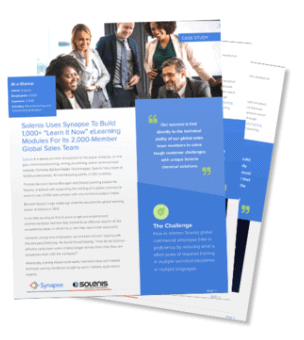“One size training does not fit all” – so says Thomas Bernard, Senior Manager and Global Learning Leader for Solenis, and it’s a wisdom that is widely accepted amongst the learning and development community. But, while we can all agree on what doesn’t work for elearning modules, figuring out alternative solutions is not always as easy as it sounds.
As a global provider of chemical solutions to a wide range of industries, Solenis has a team of 5,000 professionals in 120 countries, including a 2,000-member sales force. Due to the highly technical nature of their product and industry, Solenis rely on having a sales force with expert knowledge in order to meet key business objectives.
Solenis faced the challenge of shortening global commercial employees’ time to proficiency by reducing what is often years of required training in multiple technical disciplines in multiple languages.
Establishing Learning Gaps
Thomas Bernard faced a huge challenge when he became the global learning leader at Solenis in 2013. The first game-changer was developing and launching a detailed online assessment process to ascertain individual employees’ current knowledge levels.

Management now had oversight on the knowledge levels of each employee by individual skills and competencies. It confirmed that there were large learning gaps from employee to employee that needed to be filled.
“I wanted to find a way to build just-in-time, mobile-friendly training opportunities that would provide the coaching for just that needed skill”, says Bernard.
So now they were looking at potentially building out over 1,000 new training modules. It was important that these be bite-sized, skill-specific and accessible from multiple devices because scaling the training was not the only challenge Solenis was facing.
What to do when the learners are part of the problem?
Some of the issues Solenis faced with training employees are recognizable to any L&D professional, and some were a little more specific to their business situation.

It can take as long as 5 to 6 years to get an inexperienced commercial team member fully trained in all the competency areas in which he or she may need to be successful.
Training up until this point was primarily carried out by in-house Solenis technical experts, who had all the knowledge but none of the instructional design tools or know-how to create the training that was now needed.

It was also becoming clear that the younger millennial section of the workforce did not engage at all with the current methods of training used – VILT, classroom-based training marathons, peer reviews, and on-the-job learning – and they rebelled against this type of training in feedback to the CEO
Bernard also wanted to address the learning gaps between new employees. Some are industry veterans, while some are younger and new to the industry. With such varying knowledge levels, it was important that training be as customized as possible to fit their needs and make training as efficient and impactful as possible.
We have the problem and the solution, so what’s next?
All the benefits were clear, but how to execute this new training program became the next hurdle to overcome. The L&D team at Solenis did not have the budget to build out over 1,000 “quick hit” eLearning modules using outside learning designers.
The in-house Solenis SMEs had the technical knowledge, but their lack of instructional design knowledge and online authoring design tools made the task of building this scale of eLearning modules seem impossible.
The Solution – Bite-sized eLearning Modules
Having weighed up all elements of the challenge, Solenis took the decision to implement Cognota. “I am pretty excited and passionate about the subject, and our progress, with what I feel is a pretty revolutionary way of developing our Solenis commercial employees”.
Want to hear the full story behind Solenis’s microlearning journey? Download the full case study.




